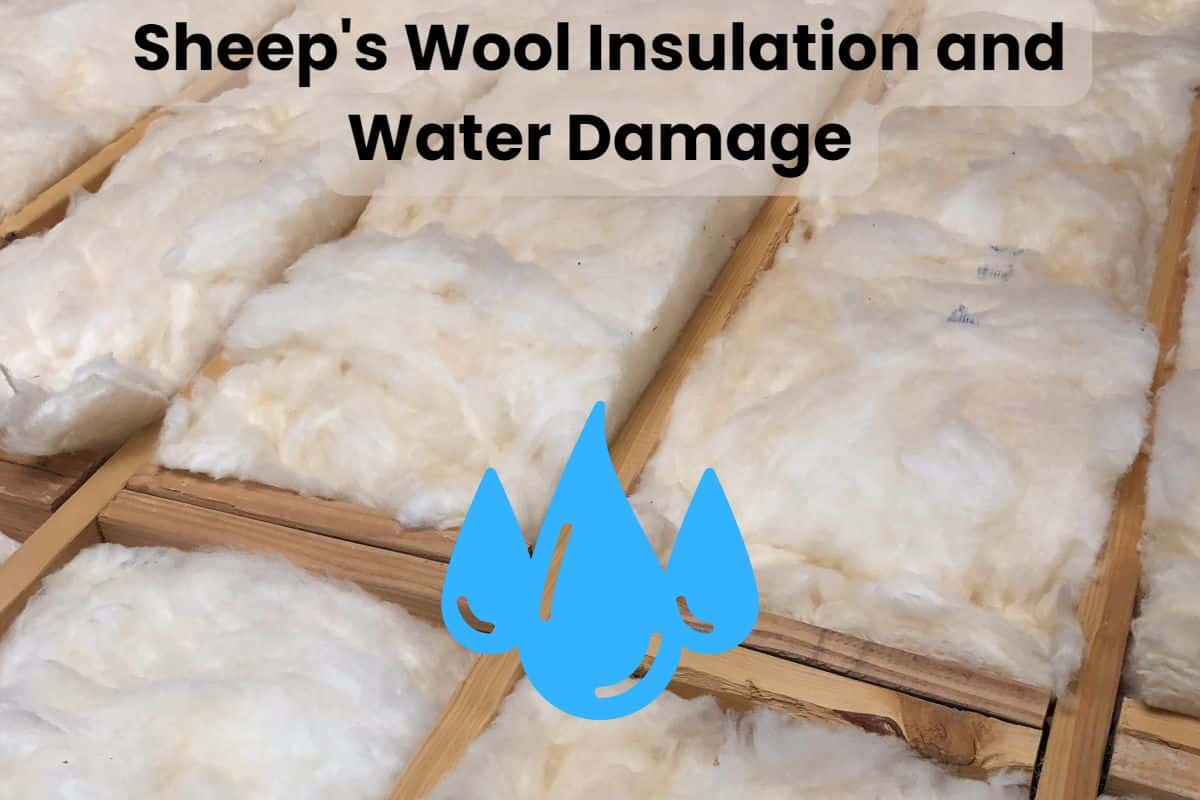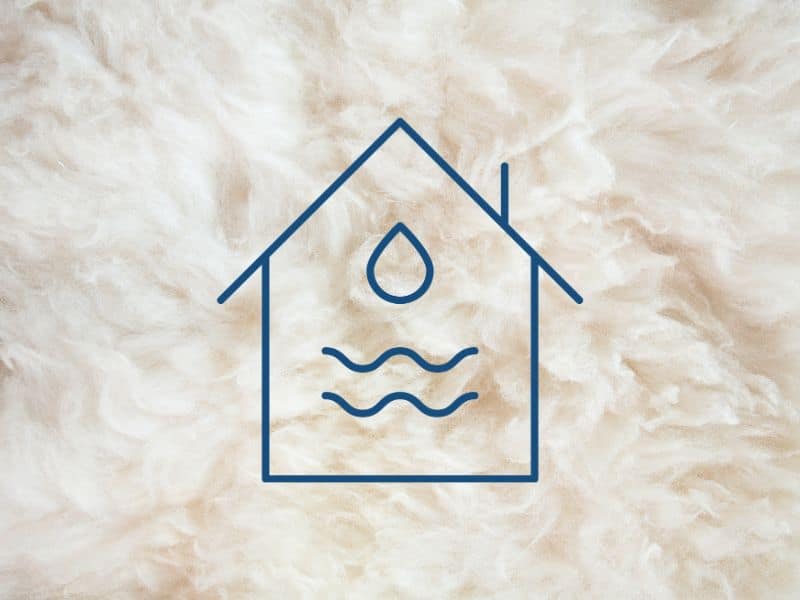Sheep’s Wool Insulation and Water Damage: Key Facts To Know

Sheep wool insulation is an excellent, environmentally friendly, renewable resource that can be used to provide natural insulation for any home.
The effectiveness of insulation is quantified by an R-value, with higher values indicating better thermal insulation. Sheep’s wool insulation has an R-value of 3.5-3.8, which is higher than many other types of insulation material, such as mineral wool or cellulose insulation.
However, as with any insulation material, it’s essential to understand the risks and take steps to properly waterproof your walls and flooring to avoid water damage.
The exterior layer of sheep’s wool is hydrophobic (water-resistant). This makes it an ideal choice for damp environments. However, its inner layer is hydrophilic, meaning it absorbs moisture. While the exterior layer can remain dry, the interior layer can absorb moisture when exposed to water.
Read on to learn more about sheep’s wool insulation and water damage.
By the end of this article, you’ll better understand how to protect your home from water damage and why sheep’s wool is an excellent choice for the natural insulation of your home.
If you’re thinking about how sheep’s wool insulation can be affected by water leaks, you might also be interested in understanding how it handles attacks from pests. Luckily, we’ve written an article for you to read – Birds And The Bees: How Animals Like Your Wool Insulation which explains it all.
Do You Need a Vapor Barrier With Sheep Wool Insulation?

You don’t need a vapor barrier with sheep wool insulation, as the exterior layer is hydrophobic and does not allow moisture to pass through. Adding an extra barrier traps moisture and increases the risk of mold and mildew, leading to structural damage, health problems, and a foul odor.
Typically, sheep wool will absorb water vapor during long-term exposure to humidity, such as in winter, and re-release it when the environment becomes dryer. This eliminates the need for a vapor barrier while providing the insulation needed to keep your home comfortable.
What Happens if Wool Insulation Gets Wet?

If sheep wool insulation gets wet, it can lose its thermal performance (R-value). The fibers become heavy and dense, reducing their ability to trap air and provide adequate thermal insulation. Your house gets colder, causing your heating and cooling bills to skyrocket and strain your HVAC system.
To prevent this, remove any visible standing water and then dry the area as quickly as possible by circulating air to reduce the moisture content.
Ensure all windows, doors, walls, and flooring, including the attic or crawlspace, are adequately sealed to prevent moisture from seeping in. You can also hire a professional to waterproof your walls and flooring if necessary.
Is Wool Waterproof or Water-Resistant?

Wool is water resistant, not waterproof. The hydrophobic exterior layer will repel water, but the interior layer can still absorb moisture if exposed for a long period. It’s essential to ensure your home is properly sealed to minimize water damage and keep your home comfortable.
Sheep wool can absorb up to a third of its weight in water and remain dry on the outside. It will only feel wet to the touch after 30% saturation.
Its water-repellent properties are due to a waxy substance, lanolin, found in wool fibers. It helps to keep moisture at bay, controlling water vapor while allowing it to breathe and maintain its thermal efficiency.
Does Wool Have Water Damage?

Since wool isn’t waterproof, it can be subject to water damage if not adequately protected. Water damage can lead to mold growth, reducing the insulation’s performance and causing structural damage. It can also lead to unhygienic conditions, electrical hazards, and decreased property value.
Fortunately, sheep wool insulation has been designed to be highly water resistant. It can handle long-term exposure to moisture and still provide adequate insulation.
However, if you live in a humid or damp area, you must take extra precautions by waterproofing your walls and floors, sealing any gaps or crevices around windows, doors, and other vulnerable areas, and keeping an eye out for any signs of water damage.
Does Sheep’s Wool Rot?

Sheep wool is biodegradable and will eventually rot if exposed to damp, humid conditions for an extended period. It takes three months to two years for wool fibers to completely decompose, depending on the external environment, the wool’s condition, and the presence of microorganisms.
To extend the life of your sheep’s wool insulation, create a dry, airy environment in your home and regularly inspect for signs of dampness, mold, mildew, or rot. You can install dehumidifiers to keep your home dry and maintain optimal insulation performance.
If the damage has already occurred and is severe, contact a professional to assess the situation and replace any compromised insulation.
Doing this can help minimize further damage, health problems, and other costly repairs. Professional installation is also recommended for new insulation to maximize its performance and longevity.
Does Sheep’s Wool Get Moldy?

Sheep’s wool gets moldy when exposed to high levels of moisture, such as in humid climates or during flooding. Mold and mildew can reduce thermal performance and create an unhygienic environment, leading to respiratory and other health issues.
Keep your home’s humidity level between 30-50% to prevent mold and mildew growth. You can also waterproof walls and floors to reduce the risk of water damage and increase insulation performance.
Regularly inspect your home for signs of water damage and take action if necessary.
There are also several ways to clean mold off sheep wool insulation. If the damage is minor, you can use a vacuum cleaner to remove the mold.
You can make a DIY mold remover for more severe cases by spraying undiluted white vinegar onto the affected area.
The acetic acid in the vinegar will soak each wool fiber and kill the spores to stop the spread of mold. Leave the vinegar on for at least 1 hour before rinsing the affected area of the sheep wool insulation with water.
If you feel uncomfortable tackling the problem, hire an experienced professional to eliminate the mold. They have the knowledge and expertise to clean and restore your insulation safely.
They may recommend replacing severely damaged sheep wool insulation with a new product.
Does Sheep Wool Insulation Absorb Water?

Sheep wool does absorb water. However, it has high breathability, absorbing and releasing moisture as required without compromising its insulation performance. Its unique wool fibers trap air and form tiny air pockets, which act as an insulator against heat transfer.
This helps maintain a comfortable and healthy indoor environment. Sheep’s wool also helps to improve indoor air quality thanks to its ability to absorb and break down volatile organic compounds like formaldehyde.
Sheep wool insulation is highly resistant to water damage due to its natural waxy coating and dense fiber structure. It won’t absorb liquid water but can still become damp from condensation resulting from water vapor.
To reduce the risk of water damage and maximize its performance, keep your home dry, install dehumidifiers, and waterproof vulnerable areas.
Final Thoughts On Sheep’s Wool Insulation and Water Damage
Overall, sheep’s wool insulation is an excellent choice for homes that tend to get damp and humid.
It’s a naturally breathable thermal insulation material, so it can help maintain an optimal indoor environment without compromising insulation performance.
However, like other insulation materials, it’s not entirely immune to water damage, so it’s essential to regularly inspect for signs of water damage and take action if necessary.
With the proper preventative measures and timely repairs, you can maintain the health and longevity of your sheep’s wool insulation.
Interested in using sheep’s wool insulation for your next project? You’ll need to find suppliers, so we’ve collated a list for you – 6 Great Companies That Make Sheep’s Wool Insulation.







